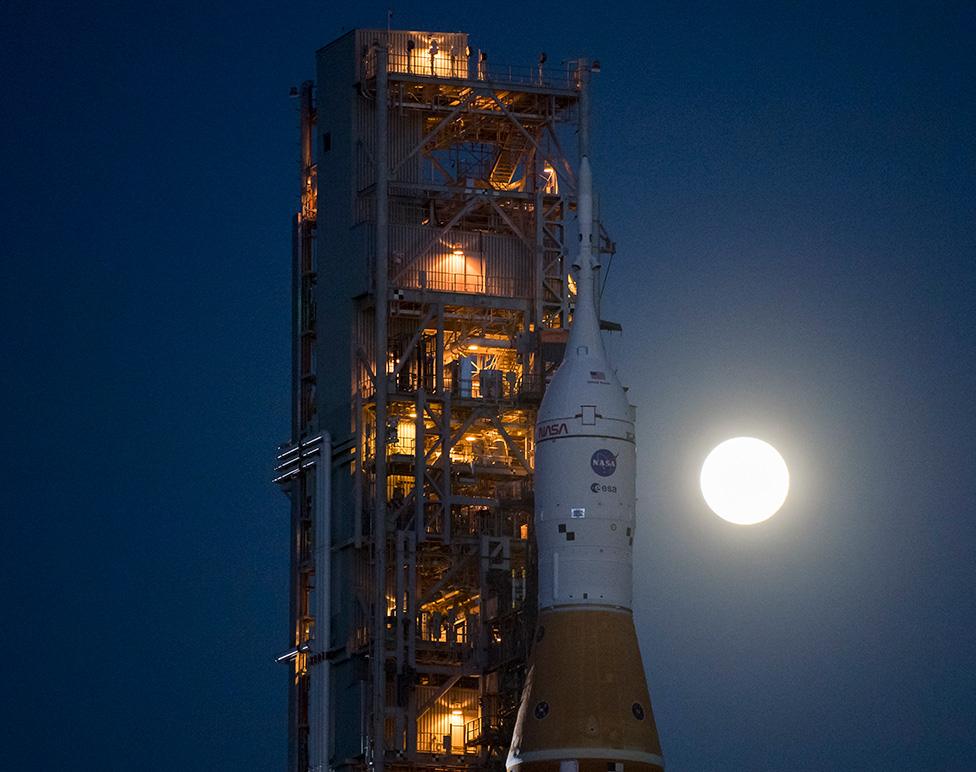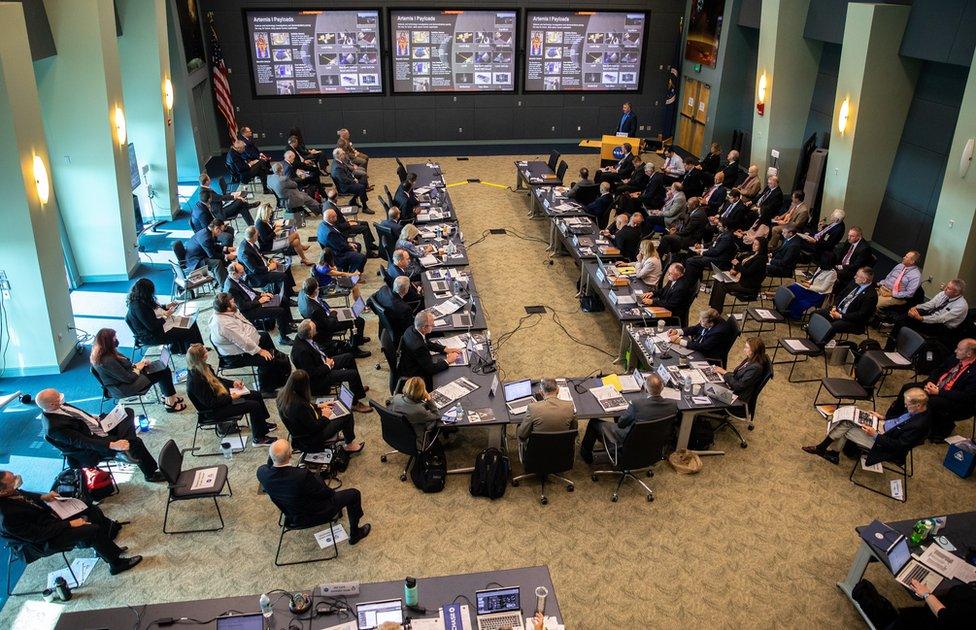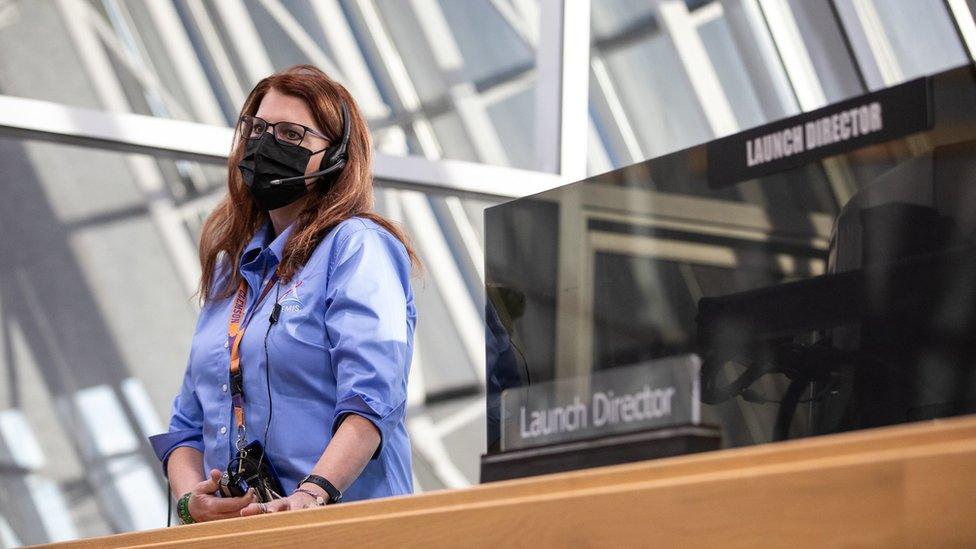Artemis: Nasa Moon mission gets go-ahead to launch
- Published

This flight to the Moon has been more than a decade in the making
The American space agency says it is ready to launch its giant new Moon rocket next Monday.
Nasa officials conducted a flight-readiness review late on Monday and concluded there were no substantive technical issues in their way.
The rocket, known as the Space Launch System, will send a capsule, called Orion, on an excursion around the Moon.
Uncrewed this time, there will be astronauts on board for subsequent missions, assuming all goes to plan.
The SLS will go up from the Kennedy Space Center (KSC) in Florida.
The vehicle has been given a two-hour window on the Monday to get off Earth, starting at 08:33 local time (12:33 GMT; 13:33 BST).
"We actually had no actions coming out of the review and we had no dissenting opinions," said Jim Free, Nasa's associate administrator for exploration systems development.

The flight readiness review found no obvious showstoppers at this stage

Watch Return To The Moon on iPlayer (UK only).

The launch will be a key moment for Nasa, which, in December, will celebrate the 50th anniversary of the last human landing on the Moon - Apollo 17.
The agency has vowed to return with its new "Artemis programme", using technology that befits the modern era (Artemis was Greek god Apollo's twin sister and goddess of the Moon).
Nasa sees a return to the Moon as a way to prepare to go to Mars with astronauts sometime in the 2030s or soon after.
"You know, right now more than half the world's population has never seen anybody walk on another world, so in many ways it is going to be their first moon walk," said Keith Cowing, the editor of the Nasa Watch website which covers Nasa news.
"We do things differently, everything is instant, everything's going to be in HD... It's going to be exciting and noisy, but at the end of the day eventually we're going to be sending humans to walk on another world and again hopefully maybe this time it'll be a global effort, not two countries competing with each other," he told BBC News.
SLS and Orion have been in development for over a decade and have cost, in each case, more than $20bn (£17bn) to get to this point.
Orion has actually flown before, once, on a near-Earth test outing in 2014. But that used an existing commercial rocket to get into space. This coming flight is therefore the first full end-to-end examination of the Artemis exploration hardware.
A guide to Nasa's mega Moon rocket

SLS and Orion were rolled out to the launch pad last week. Engineering and technical staff have spent the intervening days attaching fuel, electrical and communication lines in readiness for the big countdown.
This should begin with a "call to stations" for the Artemis I launch team at 09:53 EDT on Saturday, with the operation to load SLS with 2.7 million litres of propellants (liquid hydrogen and oxygen) set to get under way just after midnight into the Monday.
"We've completed 30 sims, so our team is certified and ready to go," said launch director Charlie Blackwell-Thompson.
Nasa is expecting hundreds of thousands of spectators to line the beaches along the space coast.
This will be the most powerful rocket ever to pull away from Kennedy, producing 39.1 meganewtons (8.8 million pounds) of thrust off the pad. That's close to 15% more than from Apollo's Saturn V rockets and over 20% more than from the old space shuttle system.
Put another way, the SLS's engines could power the equivalent of almost 60 Concorde supersonic jets on take-off.
"I can tell you there's an energy and there's an excitement around the Kennedy Space Center; I would say across the agency and all around the Space Coast as we get closer and closer to this launch," commented Janet Petro, the director at KSC.

Launch director Charlie Blackwell-Thompson will call her team to their stations on Saturday morning
Orion will be sent on a 42-day mission to, and beyond, the Moon.
It's expected back on Earth for a splashdown in the Pacific Ocean close to San Diego, California, on 10 October.
Artemis II, the first crewed mission to use SLS-Orion, is being targeted at 2024. Artemis III, the first landing on the lunar surface since 1972, won't occur any earlier than late 2025.
Nasa has yet to name any astronauts for these missions, but it has published in the last few days the locations on the lunar surface where future crews could be sent.
It has identified 13 candidate destinations. They're all within six degrees of latitude of the lunar South Pole (Apollo was largely confined to equatorial or near-equatorial landing sites).
The aim is to get close to permanently shadowed areas where water-ices are likely to have collected over billions of years.
These ices could be used for drinking water or to make rocket fuel.
Speaking shortly after the review was completed, Bob Cabana, a former shuttle astronaut and now Nasa's associate administrator, said: "I'm a product of the Apollo generation, and look what it did for us. I cannot wait to see what comes from the Artemis generation because I think it's going to inspire even more than Apollo did. It's going to be absolutely outstanding."
